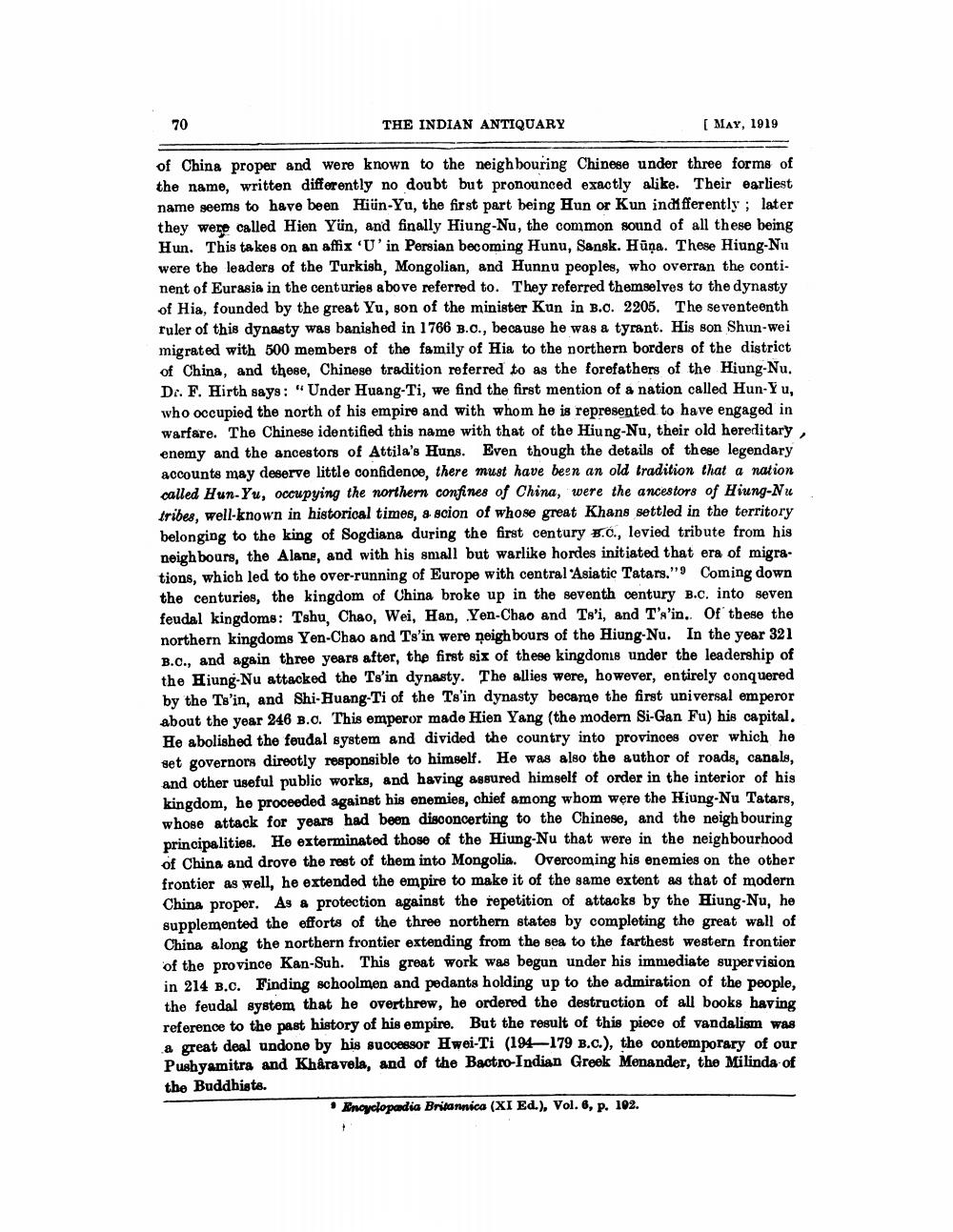________________
70
THE INDIAN ANTIQUARY
[ MAY, 1919
of China proper and were known to the neighbouring Chinese under three forms of the name, written differently no doubt but pronounced exactly alike. Their earliest name seems to have been Hiün-Yu, the first part being Hun or Kun indifferently ; later they were called Hien Yün, and finally Hiung-Nu, the common sound of all these being Hun. This takes on an affix 'U' in Persian becoming Hunu, Sansk. Hūņa. These Hiung-Nu were the leaders of the Turkish, Mongolian, and Hunnu peoples, who overran the continent of Eurasia in the centuries above referred to. They referred themselves to the dynasty of Hia, founded by the great Yu, son of the minister Kun in B.c. 2205. The seventeenth ruler of this dynasty was banished in 1766 B.C., because he was a tyrant. His son Shun-wei migrated with 500 members of the family of Hia to the northern borders of the district of China, and these, Chinese tradition referred to as the forefathers of the Hiung.Nu. Dr. F. Hirth says: "Under Huang-Ti, we find the first mention of a nation called Hun-Yu, who occupied the north of his empire and with whom he is represented to have engaged in warfare. The Chinese identified this name with that of the Hiung-Nu, their old hereditary, enemy and the ancestors of Attila's Huns. Even though the details of these legendary accounts may deserve little confidence, there must have been an old tradition that a nation called Hun-Yu, occupying the northern confines of China, were the ancestors of Hiung-Nu tribes, well-known in historical times, a scion of whose great Khans settled in the territory belonging to the king of Sogdiana during the first century B.o., levied tribute from his neighbours, the Alane, and with his small but warlike hordes initiated that era of migrations, which led to the over-running of Europe with central Asiatic Tatars."9 Coming down the centuries, the kingdom of China broke up in the seventh century B.c. into seven feudal kingdoms: Tshu, Chao, Wei, Han, Yen-Chao and Ts'i, and T's'in. Of these the northern kingdoms Yen-Chao and Ts'in were neighbours of the Hiung-Nu. In the year 321 B.C., and again three years after, the first six of these kingdonis under the leadership of the Hiung-Nu attacked the Ts'in dynasty. The allies were, however, entirely conquered by the Ts'in, and Shi-Huang-Ti of the Ts'in dynasty became the first universal emperor about the year 246 B.C. This emperor made Hien Yang (the modern Si-Gan Fu) his capital, He abolished the feudal system and divided the country into provinces over which he set governors directly responsible to himself. He was also the author of roads, canals, and other useful public works, and having assured himself of order in the interior of his kingdom, he proceeded against his enemies, chief among whom were the Hjung-Nu Tatars, whose attack for years had been disconcerting to the Chinese, and the neighbouring principalities. He exterminated those of the Hiung-Nu that were in the neighbourhood of China and drove the rest of them into Mongolia. Overcoming his enemies on the other frontier as well, he extended the empire to make it of the same extent as that of modern China proper. As a protection against the repetition of attacks by the Hiung-Nu, he supplemented the efforts of the three northern states by completing the great wall of China along the northern frontier extending from the sea to the farthest western frontier of the province Kan-Suh. This great work was begun under his immediate supervision in 214 B.C. Finding schoolmen and pedants holding up to the admiration of the people, the feudal system that he overthrew, he ordered the destruction of all books having reference to the past history of his empire. But the result of this piece of vandalism was a great deal undone by his successor Hwei-Ti (194—179 B.c.), the contemporary of our Pushvamitra and Khåravela, and of the Bactro-Indian Greek Menander, the Milinda of the Buddhists.
• Engclopadia Britannica (XI Ed.), Vol. 6, p. 102.




